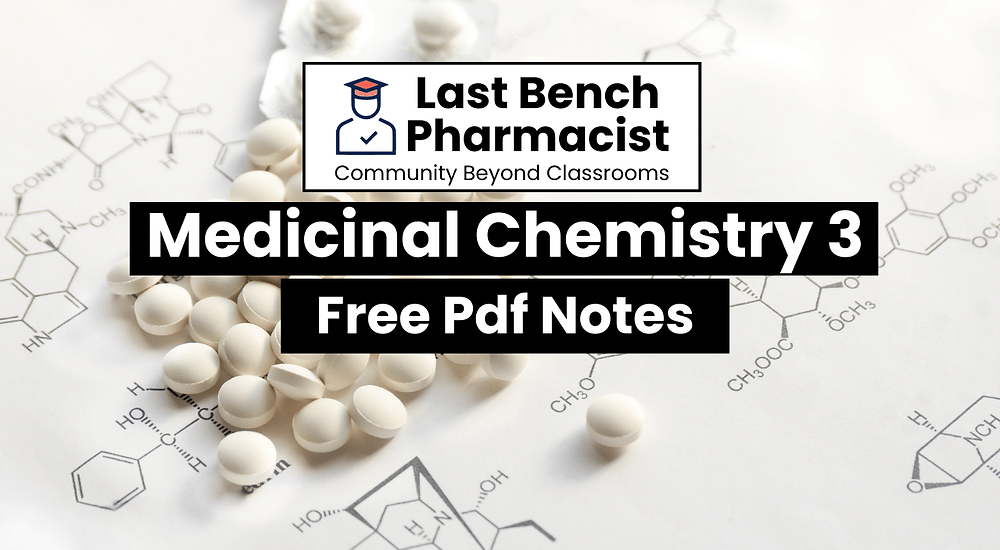



#bpharmnotes #bpharmMedicinalChemistry3notes #bpharmpdfnotes
Buckle up, B-Pharmers, because B Pharm Medicinal Chemistry 3 Pdf Notes is about to take your brain on a wild ride through the molecular jungle of antibiotics, antifungals, and antivirals! Think of it as a microscopic Game of Thrones, where bacteria, fungi, and viruses battle for dominance, and you, the fearless pharmacist-to-be, wield the power of potent chemicals to restore order. We’ll be crafting wonder weapons like penicillin and cephalosporins to dethrone the bacterial kings, concocting antifungal elixirs like griseofulvin to topple the fungal tyrants, and unleashing antiviral armies like acyclovir to vanquish the viral invaders. Along the way, we’ll decipher the cryptic codes of molecular structures, understand the intricate dance of side effects and efficacy, and learn to wield these chemical weapons with the precision of a sharpshooter.
Scope:
This subject is designed to impart fundamental knowledge on the structure, chemistry and therapeutic value of drugs. The subject emphasis on modern techniques of rational drug design like quantitative structure activity relationship (QSAR), Prodrug concept, combinatorial chemistry and Computer aided drug design (CADD). The subject also emphasizes on the chemistry, mechanism of action, metabolism, adverse effects, Structure Activity Relationships (SAR), therapeutic uses and synthesis of important drugs.
Objectives: Upon completion of the subject student shall be able to:
Understand the importance of drug design and different techniques of drug design.
Understand the chemistry of drugs with respect to their biological activity.
Know the metabolism, adverse effects and therapeutic value of drugs.
Know the importance of SAR of drugs.
Antibiotics
Historical background, Nomenclature, Stereochemistry, Structure activity relationship, Chemical degradation classification and important products of the following classes.
β-Lactam antibiotics:
Penicillin, Cepholosporins, β- Lactamase inhibitors, Monobactams
Aminoglycosides: Streptomycin, Neomycin, Kanamycin
Tetracyclines: Tetracycline,Oxytetracycline, Chlortetracycline, Minocycline, Doxycycline
Antibiotics
Historical background, Nomenclature, Stereochemistry, Structure activity relationship, Chemical degradation classification and important products of the following classes.
Macrolide: Erythromycin Clarithromycin, Azithromycin
Miscellaneous: Chloramphenicol*, Clindamycin.
Prodrugs: Basic concepts and application of prodrugs design
Antimalarials: Etiology of malaria.
Quinolines: SAR, Quinine sulphate, Chloroquine*, Amodiaquine, Primaquine phosphate, Pamaquine*, Quinacrine hydrochloride, Mefloquine.
Biguanides and dihydro triazines: Cycloguanil pamoate, Proguanil.
Miscellaneous: Pyrimethamine, Artesunete, Artemether, Atovoquone.
Anti-tubercular Agents
Synthetic anti tubercular agents: Isoniozid*, Ethionamide, Ethambutol, Pyrazinamide, Para amino salicylic acid.*
Anti tubercular antibiotics: Rifampicin, Rifabutin, Cycloserine Streptomycine, Capreomycin sulphate.
Urinary tract anti-infective agents
Quinolones: SAR of quinolones, Nalidixic Acid,Norfloxacin, Enoxacin, Ciprofloxacin*, Ofloxacin, Lomefloxacin, Sparfloxacin, Gatifloxacin, Moxifloxacin
Miscellaneous: Furazolidine, Nitrofurantoin*, Methanamine.
Antiviral agents:
Amantadine hydrochloride, Rimantadine hydrochloride, Idoxuridine trifluoride, Acyclovir*, Gancyclovir, Zidovudine, Didanosine, Zalcitabine, Lamivudine, Loviride, Delavirding, Ribavirin, Saquinavir, Indinavir, Ritonavir.
Antifungal agents:
Antifungal antibiotics: Amphotericin-B, Nystatin, Natamycin, Griseofulvin.
Synthetic Antifungal agents: Clotrimazole, Econazole, Butoconazole, Oxiconazole Tioconozole, Miconazole*, Ketoconazole, Terconazole, Itraconazole, Fluconazole, Naftifine hydrochloride, Tolnaftate*.
Anti-protozoal Agents: Metronidazole*, Tinidazole, Ornidazole, Diloxanide, Iodoquinol, Pentamidine Isethionate, Atovaquone, Eflornithine.
Anthelmintics: Diethylcarbamazine citrate*, Thiabendazole, Mebendazole*, Albendazole, Niclosamide, Oxamniquine, Praziquantal, Ivermectin.
Sulphonamides and Sulfones
Historical development, chemistry, classification and SAR of Sulfonamides: Sulphamethizole, Sulfisoxazole, Sulphamethizine, Sulfacetamide*, Sulphapyridine, Sulfamethoxaole*, Sulphadiazine, Mefenide acetate, Sulfasalazine
Folate reductase inhibitors: Trimethoprim*, Cotrimoxazole.
Sulfones: Dapsone*
Introduction to Drug Design
Various approaches used in drug design.
Physicochemical parameters used in quantitative structure activity relationship (QSAR) such as partition coefficient, Hammet’s electronic parameter, Tafts steric parameter and Hansch analysis.
Pharmacophore modeling and docking techniques
Combinatorial Chemistry: Concept and applications chemistry: solid phase and solution phase synthesis.